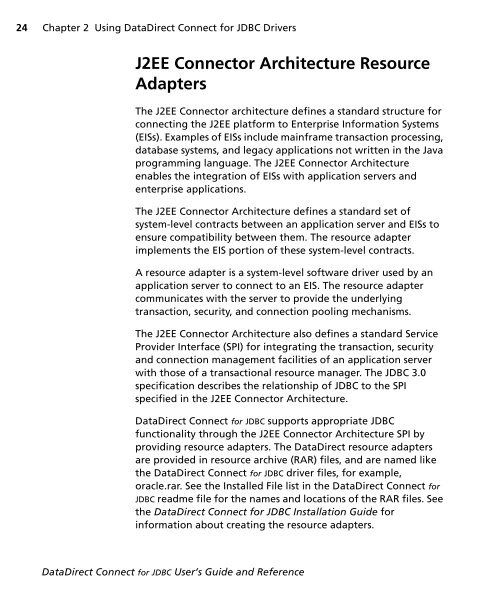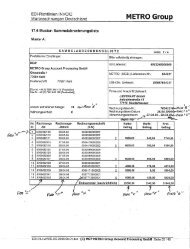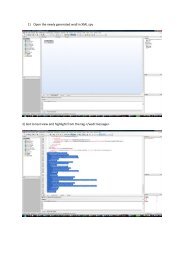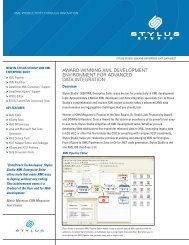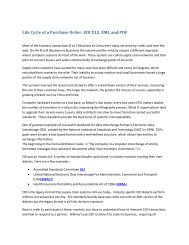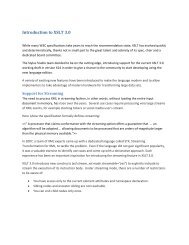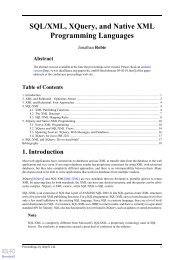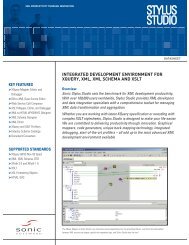- Page 1 and 2: DataDirect Connect ® for JDBC ® U
- Page 3 and 4: 3 Table of Contents Preface . . . .
- Page 5 and 6: Table of Contents 5 5 The Oracle Dr
- Page 7 and 8: Table of Contents 7 Retrieving Data
- Page 9 and 10: 9 Preface This book is your guide t
- Page 11 and 12: Typographical Conventions 11 Typogr
- Page 13 and 14: Contacting Technical Support 13 Loc
- Page 15 and 16: 15 1 Quick Start Connect This chapt
- Page 17 and 18: Connecting to a Database 17 3. Pass
- Page 19 and 20: Testing the Connection 19 See the t
- Page 21 and 22: 21 2 Using DataDirect Connect for J
- Page 23: About the Product 23 DataDirect Spy
- Page 27 and 28: About the Product 27 env.put(Contex
- Page 29 and 30: Connecting Through the JDBC Driver
- Page 31 and 32: Connecting Through Data Sources 31
- Page 33 and 34: Connecting Through Data Sources 33
- Page 35 and 36: Testing Connections 35 Testing Conn
- Page 37 and 38: Error Handling 37 The JDBC API prov
- Page 39 and 40: 39 3 The DB2 Driver The DataDirect
- Page 41 and 42: Connection String Properties 41 Con
- Page 43 and 44: Connection String Properties 43 Tab
- Page 45 and 46: Creating a DB2 Package 45 Complete
- Page 47 and 48: Creating a DB2 Package 47 Example f
- Page 49 and 50: SQL Escape Sequences 49 SQL Escape
- Page 51 and 52: 51 4 The Informix Driver The DataDi
- Page 53 and 54: Data Types 53 Table 4-1. Informix C
- Page 55 and 56: Using Scrollable Cursors 55 Using S
- Page 57 and 58: 57 5 The Oracle Driver The DataDire
- Page 59 and 60: Connection String Properties 59 Tab
- Page 61 and 62: Oracle9i Data Type Support 61 Table
- Page 63 and 64: Oracle9i Data Type Support 63 When
- Page 65 and 66: SQL Escape Sequences 65 "123Mark'))
- Page 67 and 68: Batch Inserts and Updates 67 Oracle
- Page 69 and 70: 69 6 The SQL Server Driver The Data
- Page 71 and 72: Connection String Properties 71 Tab
- Page 73 and 74: Connecting to Named Instances 73 Co
- Page 75 and 76:
SQL Escape Sequences 75 Table 6-2.
- Page 77 and 78:
Large Object (LOB) Support 77 2 Fro
- Page 79 and 80:
79 7 The Sybase Driver The DataDire
- Page 81 and 82:
Connection String Properties 81 Tab
- Page 83 and 84:
Data Types 83 Table 7-1. Sybase Con
- Page 85 and 86:
Isolation Levels 85 Isolation Level
- Page 87 and 88:
87 A JDBC Support This appendix pro
- Page 89 and 90:
Supported Functionality 89 Blob Obj
- Page 91 and 92:
Supported Functionality 91 Callable
- Page 93 and 94:
Supported Functionality 93 Callable
- Page 95 and 96:
Supported Functionality 95 Callable
- Page 97 and 98:
Supported Functionality 97 Connecti
- Page 99 and 100:
Supported Functionality 99 Connecti
- Page 101 and 102:
Supported Functionality 101 Databas
- Page 103 and 104:
Supported Functionality 103 Databas
- Page 105 and 106:
Supported Functionality 105 Databas
- Page 107 and 108:
Supported Functionality 107 Databas
- Page 109 and 110:
Supported Functionality 109 Databas
- Page 111 and 112:
Supported Functionality 111 Paramet
- Page 113 and 114:
Supported Functionality 113 Paramet
- Page 115 and 116:
Supported Functionality 115 Prepare
- Page 117 and 118:
Supported Functionality 117 Prepare
- Page 119 and 120:
Supported Functionality 119 ResultS
- Page 121 and 122:
Supported Functionality 121 ResultS
- Page 123 and 124:
Supported Functionality 123 ResultS
- Page 125 and 126:
Supported Functionality 125 ResultS
- Page 127 and 128:
Supported Functionality 127 ResultS
- Page 129 and 130:
Supported Functionality 129 Stateme
- Page 131 and 132:
Supported Functionality 131 XADataS
- Page 133 and 134:
133 B GetTypeInfo The following tab
- Page 135 and 136:
DB2 Driver 135 Table B-1. GetTypeIn
- Page 137 and 138:
DB2 Driver 137 Table B-1. GetTypeIn
- Page 139 and 140:
DB2 Driver 139 Table B-1. GetTypeIn
- Page 141 and 142:
Informix Driver 141 Informix Driver
- Page 143 and 144:
Informix Driver 143 Table B-2. GetT
- Page 145 and 146:
Informix Driver 145 Table B-2. GetT
- Page 147 and 148:
Informix Driver 147 Table B-2. GetT
- Page 149 and 150:
Oracle Driver 149 Oracle Driver Tab
- Page 151 and 152:
Oracle Driver 151 Table B-3. GetTyp
- Page 153 and 154:
Oracle Driver 153 Table B-3. GetTyp
- Page 155 and 156:
SQL Server Driver 155 Table B-4. Ge
- Page 157 and 158:
SQL Server Driver 157 Table B-5. Ge
- Page 159 and 160:
SQL Server Driver 159 Table B-5. Ge
- Page 161 and 162:
SQL Server Driver 161 Table B-5. Ge
- Page 163 and 164:
SQL Server Driver 163 Table B-5. Ge
- Page 165 and 166:
SQL Server Driver 165 Table B-5. Ge
- Page 167 and 168:
Sybase Driver 167 Sybase Driver Tab
- Page 169 and 170:
Sybase Driver 169 Table B-7. GetTyp
- Page 171 and 172:
Sybase Driver 171 Table B-7. GetTyp
- Page 173 and 174:
Sybase Driver 173 Table B-7. GetTyp
- Page 175 and 176:
175 C Designing JDBC Applications f
- Page 177 and 178:
Using Database Metadata Methods 177
- Page 179 and 180:
Retrieving Data 179 only prepared.
- Page 181 and 182:
Selecting JDBC Objects and Methods
- Page 183 and 184:
Selecting JDBC Objects and Methods
- Page 185 and 186:
Designing JDBC Applications 185 For
- Page 187 and 188:
Designing JDBC Applications 187 amo
- Page 189 and 190:
Updating Data 189 Using getBestRowI
- Page 191 and 192:
191 D SQL Escape Sequences for JDBC
- Page 193 and 194:
Scalar Functions 193 Table D-1. Sca
- Page 195 and 196:
Scalar Functions 195 Table D-1. Sca
- Page 197 and 198:
Scalar Functions 197 Table D-1. Sca
- Page 199 and 200:
Procedure Call Escape Sequences 199
- Page 201 and 202:
201 E Using DataDirect Test This ch
- Page 203 and 204:
DataDirect Test Tutorial 203 Starti
- Page 205 and 206:
DataDirect Test Tutorial 205 The ma
- Page 207 and 208:
DataDirect Test Tutorial 207 3 If t
- Page 209 and 210:
DataDirect Test Tutorial 209 3 Sele
- Page 211 and 212:
DataDirect Test Tutorial 211 Execut
- Page 213 and 214:
DataDirect Test Tutorial 213 Execut
- Page 215 and 216:
DataDirect Test Tutorial 215 5 Sele
- Page 217 and 218:
DataDirect Test Tutorial 217 Retrie
- Page 219 and 220:
DataDirect Test Tutorial 219 7 Sele
- Page 221 and 222:
DataDirect Test Tutorial 221 5 Sele
- Page 223 and 224:
DataDirect Test Tutorial 223 Batch
- Page 225 and 226:
DataDirect Test Tutorial 225 6 Sele
- Page 227 and 228:
DataDirect Test Tutorial 227 Return
- Page 229 and 230:
DataDirect Test Tutorial 229 Establ
- Page 231 and 232:
DataDirect Test Tutorial 231 5 Sele
- Page 233 and 234:
DataDirect Test Tutorial 233 Click
- Page 235 and 236:
DataDirect Test Tutorial 235 Click
- Page 237 and 238:
DataDirect Test Tutorial 237 5 Sele
- Page 239 and 240:
DataDirect Test Tutorial 239 10 The
- Page 241 and 242:
DataDirect Test Tutorial 241 5 Sele
- Page 243 and 244:
DataDirect Test Tutorial 243 13 The
- Page 245 and 246:
DataDirect Test Tutorial 245 5 Sele
- Page 247 and 248:
DataDirect Test Tutorial 247 11 The
- Page 249 and 250:
DataDirect Test Tutorial 249 5 Clic
- Page 251 and 252:
DataDirect Test Tutorial 251 9 Chan
- Page 253 and 254:
DataDirect Test Tutorial 253 11 Cli
- Page 255 and 256:
255 F Tracking JDBC Calls with Data
- Page 257 and 258:
DataDirect Spy URL Syntax and Attri
- Page 259 and 260:
Using DataDirect Spy with JDBC Data
- Page 261 and 262:
DataDirect Spy Log Example 261 spy>
- Page 263 and 264:
263 G Connection Pool Manager Estab
- Page 265 and 266:
Creating a Data Source 265 If you w
- Page 267 and 268:
Creating a Data Source 267 Connect
- Page 269 and 270:
Connecting to a Data Source 269 } r
- Page 271 and 272:
Connecting to a Data Source 271 int
- Page 273 and 274:
Description of DataDirect Connectio
- Page 275 and 276:
Description of DataDirect Connectio
- Page 277 and 278:
277 Index A AddToCreateTable (DB2)
- Page 279 and 280:
Index 279 configuring 202 connectin
- Page 281 and 282:
Index 281 L literals arguments, usi
- Page 283 and 284:
Index 283 PreparedStatement object
- Page 285 and 286:
Index 285 User DB2 43 Informix 53 O


